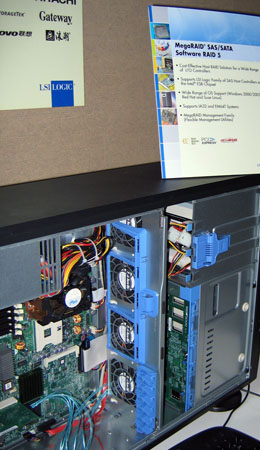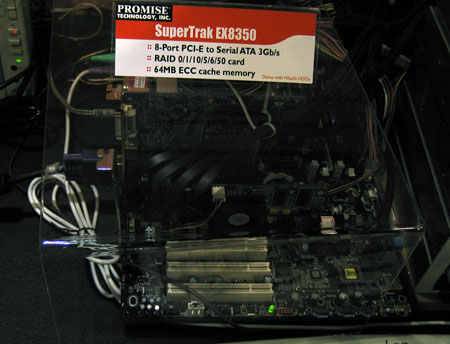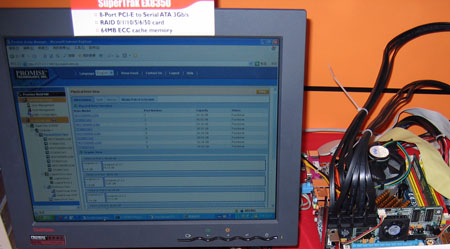Storage
Everyone and everybody couldn’t stop talking about Raid 6 at the show this year. Raid 6, for those not familiar, is a striping technology similar to Raid 5, but considerably more resource and CPU intensive. On the upside, a Raid 6 array can lose as many as two disks before failure, and even the loss of one or two disks will force the array to begin repairing itself in the background. The only downside to this technology, because it is so CPU intensive, is that it only comes in software form. The hardware is still needed to support Raid 6, but a software driver is what actually enables the technology. The other downside is that many disks are needed for Raid 6 to really become viable. Don’t expect to run this on your desktop to increase World of Warcraft performance – this is pretty much server level technology. There were also some new SAS and Infiniband controllers on the show floor at HighPoint, and those are technologies that we will definitely keep an eye on.
LSI
Besides their Raid 6 demonstrations, LSI also had a considerable amount of their suite dedicated to MegaRAID, their SAS and SATA software RAID 5 solution. While BSD operating systems have enjoyed Raid 5 software RAID via the OS for years, Linux and Windows have not been as fortunate. MegaRAID will support 32-bit and 64-bit operating systems.

Click to enlarge.
Promise
Below, you can see a shot of Promise’s Raid 8-port SATA controller with Raid 6 support and 64MB of ECC cache on board.

Click to enlarge.

Click to enlarge.
NetCell
Running from meeting to meeting, we met a very interesting employee from a company called NetCell. While we don’t have exact details at the moment, the NetCell employee mentioned that they were developing a transparent technology that built Raid 3 arrays. Raid 3 works similarly in the manner of Raid 5, but an entire hard disk is devoted to parity instead. Thus, one could lose an entire drive (or the parity drive) and still function fine. The advantage is performance – there are fewer duplicate writes – but a three-disk array only has the capacity of two disks. What NetCell aims to do is make this technology completely transparent to the user. Plugging three drives into the NetCell controller will set up the raid stripe automatically and further configuration is handled by the chip. Since there is no CPU overhead (unlike Raid 6), NetCell might have a pretty interesting technology in the near future – particularly for gamers and enthusiasts.
35 Comments
View All Comments
Doormat - Thursday, June 2, 2005 - link
@#17RAID 5 is an improvement over RAID-3 because any time you wrote to any one of the data drives, you'd have to write to the pairty drive - you're essentially write-speed bottlenecked by the write speeds of the pairty drive (unless you manage to cache the writes but that still doesnt solve the underlying architectural flaw). You could still read from the array quite fast however.
RAID-5 gets over this by spreading out the parity so when you write data to one of the array's disks, its more or less going to write the parity out to a random drive in the array instead of one dedicated drive.
n7 - Thursday, June 2, 2005 - link
@ #20Nice detective skillz :)
I hope you are right about that...would be a nice surprise if so.
ImJacksAmygdala - Thursday, June 2, 2005 - link
I think Lian Li needs to take a good hard look at the Antec P180 design and stop wasting R&D time and money on concept crap that will never sell in the market.The P180 design could be improved if the drive cages and feet could be reconfigured so that the case could be used up right as a tower or on its side as a HTPC case. Its a shame that Antec did not think of this when it was developing the P180. Whats worse is that the bottom of the P180 doesn't have a brushed aluminum finish and the feet are going to be difficult to move.
Chunkee - Thursday, June 2, 2005 - link
How about some improvment on the photos please.jC
yacoub - Thursday, June 2, 2005 - link
In case anyone is curious about the earthquake:http://earthquake.usgs.gov/recenteqsww/Quakes/usyu...
RyanVM - Thursday, June 2, 2005 - link
So you said not to expect the X550 until R520 launches. I couldn't help but notice that the placard that the X550 was on said it's launching on June 15. Does that mean what I think that means? ;-)yacoub - Thursday, June 2, 2005 - link
"4 bay faceplates in the Enermax case, "Hey look! We got pretty lights!""That case starred in the upcoming movie remake of The War of the Worlds.
ProviaFan - Thursday, June 2, 2005 - link
JHutch, I remember being told that RAID 5 was an improvement over RAID 3, because having the parity distributed over all disks balances the workload more evenly over every disk. Whether this still applies, I don't know.JHutch - Thursday, June 2, 2005 - link
Maybe someone can clarify RAID 3 vs RAID 5 for me. It looks like they are both basically striped data with a parity data block. RAID 3 seems to put all the parity on one disk, while RAID 5 spreads it around the array of disks.Supposing I have that much right, what are the advantages/disadvantages of one over the other?
Jynx980 - Thursday, June 2, 2005 - link
"The ATOP bundle pictured below consists of an AGP GeForce 6200 video card piggy-backed onto the ATOP adaptor."Below -> Above
Bahaha! Love that sign in the HIS X550 pic "New" written in silver pen! That said, the info on the signs that hold the card are damn good.
4 bay faceplates in the Enermax case, "Hey look! We got pretty lights!"
The MGE prototype case looks pretty slick. Makes me think about the shrinking room in Charlie and the Chocolate Factory.